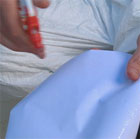Pet owners don’t like to admit that their dogs and cats have fleas. In fact, fleas can be very hard to see, particularly in dark coated animals. Dr Chris Brown demonstrated an easy method of detecting fleas that doesn’t cost anything and can be done at home. He also looked at the latest flea control methods for both the pet and its environment.
Flea detection test:
Wet an A4 sheet of white paper. Hold the paper next to your pet’s rump (where fleas love to congregate). Ruffle the fur so that bits of dirt from the coat fall onto the wet paper. Streaks of red (wet flea poo) are tell-tale signs that fleas are present.
Control methods:
Flea control requires a two-pronged approach: both the pet and its environment must be treated. Only 5% of a flea population is on the animal, the rest is in the environment (10% pupae, 35% larvae, 50% eggs).
Non chemical:
There has been very little credible research done on herbal treatments. Their only potential use is as a deterrent to fleas on a flea-free animal. They may be the safest for humans to use, but their effectiveness at this point in time is doubtful.
The most effective “non-chemical” flea control is daily vacuuming of all the hard to reach places, including sofas, beds, mattresses, cushions, curtains and doormats. Used in conjunction with proper topical controls, vacuuming will help to reduce fleas and eggs in the environment. Special attention should also be paid to the animal’s bedding, which should be washed in bleach and aired to dry regularly.
Chemical:
The older generation of topical flea control products (especially organophosphate baths and powders) is now completely obsolete. The latest treatments are top-spots, which are much safer for both pets and humans. These are topically applied chemicals that disperse through the skin’s oils. They are applied monthly. They include Advantage, Frontline and Revolution. They all kill fleas around 24 hours after a flea has bitten a treated animal. Frontline also sterilises any eggs that may be laid in the 24 hour period after drug contact, so it may provide more efficient environmental control. Frontline also controls ticks when used every two weeks.
Chris recommended using a flea bomb to treat the pet’s environment. These may be very effective means of control, but prolonged exposure or ingestion can be harmful so it is important to follow the directions closely. Cover fish tanks, remove pets, close cupboards, don’t leave food out and wipe down food preparation surfaces after application. Stay out of the house for at least two hours after using the bomb, and air the rooms after returning. Exposure to particulate matter in the bombs is a health risk, so allow the dust to settle. It is also important not to leave any pilot lights on or naked flames burning.
Further information
Top-spots such as Frontline, Advantage and Revolution start from around $30 for a three month supply. Available from Veterinarians.
Flea Bombs cost from $11.00 for a pack of two. Available from supermarkets.



